The Lenovo ThinkStation P900 Workstation Review: Design 101
by Ian Cutress on May 6, 2015 7:00 AM ESTSystem Benchmarks
Power Consumption
Power consumption was tested on the system at the wall. This method of power reading allows us to compare the power management of the UEFI and the board to supply components with power under load, and includes typical PSU losses due to efficiency. These are the real world values that consumers may expect from a typical system (minus the monitor).

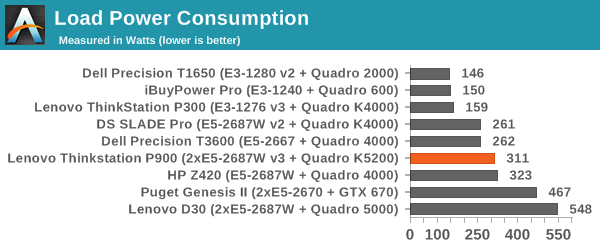
Idle power consumption, compared to some of the other big systems, is actually rather good due to the 1300 W Platinum power supply. Load consumption for a 2P system was also lower than expected, giving 231W for both CPUs between load and idle power results.
Windows 7 POST Time
Different motherboards have different POST sequences before an operating system is initialized. A lot of this is dependent on the board itself, and POST boot time is determined by the controllers on board (and the sequence of how those extras are organized). As part of our testing, we look at the POST Boot Time using a stopwatch. This is the time from pressing the ON button on the computer to when Windows 7 starts loading. (We discount Windows loading as it is highly variable given Windows specific features.)
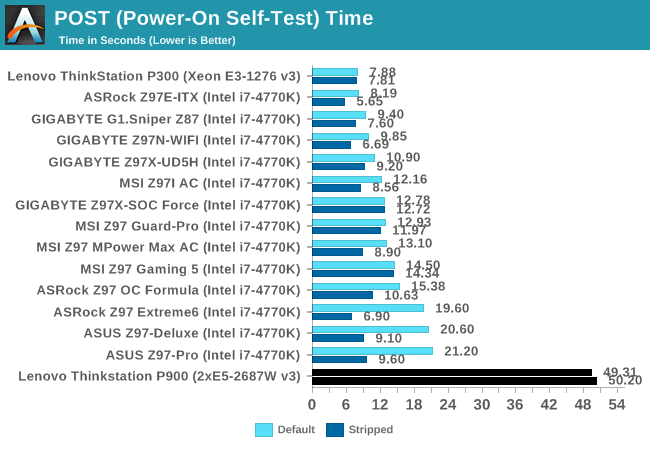
As with most 2P systems, POST time is rather long. There is no management IC on this system, but DDR4 training for each socket easily accounts for 20-30 seconds of the POST time.
Rightmark Audio Analyzer 6.2.5
Rightmark:AA indicates how well the sound system is built and isolated from electrical interference (either internally or externally). For this test we connect the Line Out to the Line In using a short six inch 3.5mm to 3.5mm high-quality jack, turn the OS speaker volume to 100%, and run the Rightmark default test suite at 192 kHz, 24-bit. The OS is tuned to 192 kHz/24-bit input and output, and the Line-In volume is adjusted until we have the best RMAA value in the mini-pretest. We look specifically at the Dynamic Range of the audio codec used on board, as well as the Total Harmonic Distortion + Noise.

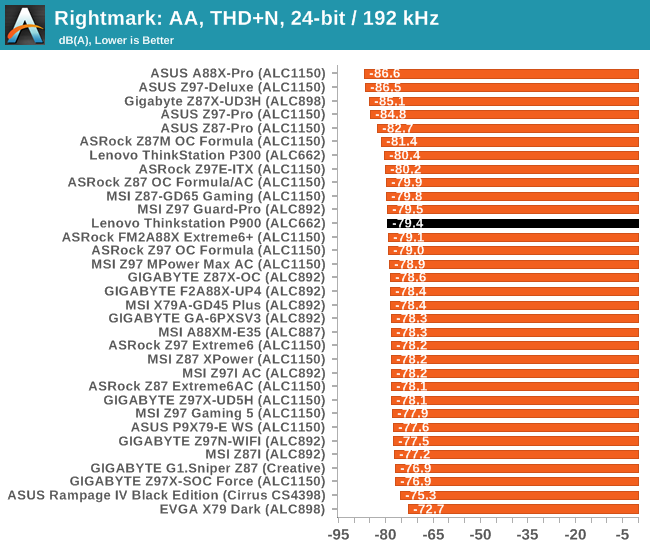
The ALC662 is a laptop audio codec at best, and as a result the P900 joins the P300 down at the bottom of our charts. The THD+N result is actually not that bad in retrospect.
USB Backup
For this benchmark, we transfer a set size of files from the SSD to the USB drive using DiskBench, which monitors the time taken to transfer. The files transferred are a 1.52 GB set of 2867 files across 320 folders – 95% of these files are small typical website files, and the rest (90% of the size) are small 30 second HD videos. In an update to pre-Z87 testing, we also run MaxCPU to load up one of the threads during the test which improves general performance up to 15% by causing all the internal pathways to run at full speed.
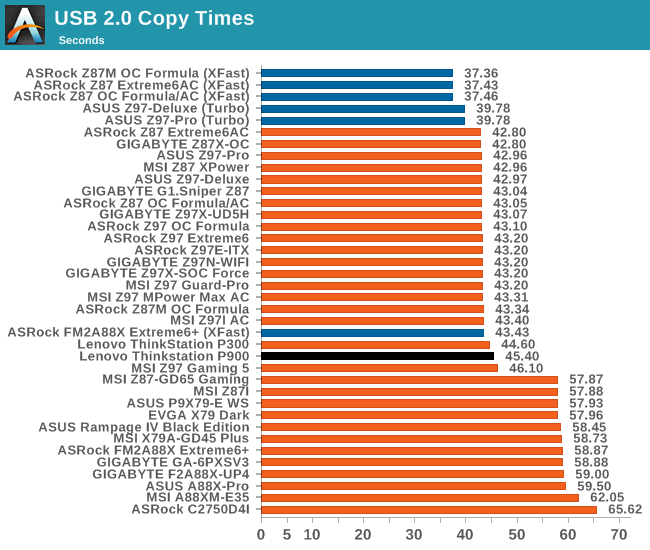
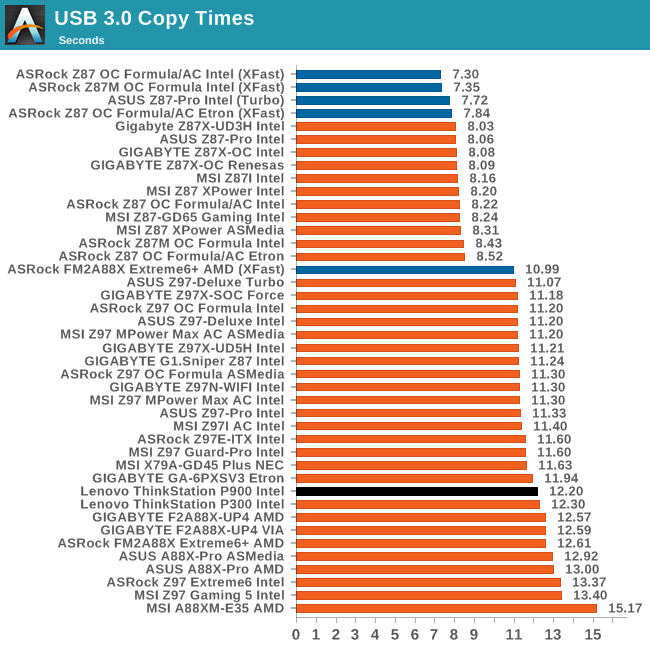
USB 2.0 perfromance follows that of our other 9-series testing, while USB 3.0 perfomance for the P900 is similar to the P300.
DPC Latency
Deferred Procedure Call latency is a way in which Windows handles interrupt servicing. In order to wait for a processor to acknowledge the request, the system will queue all interrupt requests by priority. Critical interrupts will be handled as soon as possible, whereas lesser priority requests such as audio will be further down the line. If the audio device requires data, it will have to wait until the request is processed before the buffer is filled.
If the device drivers of higher priority components in a system are poorly implemented, this can cause delays in request scheduling and process time. This can lead to an empty audio buffer and characteristic audible pauses, pops and clicks. The DPC latency checker measures how much time is taken processing DPCs from driver invocation. The lower the value will result in better audio transfer at smaller buffer sizes. Results are measured in microseconds.
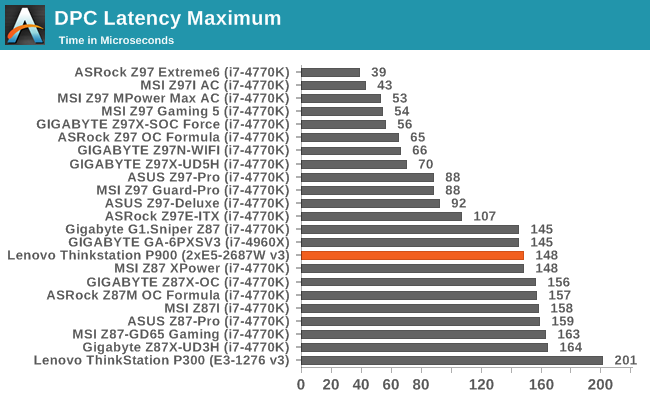
Normally 2P systems have horrendous DPC Latency numbers, but the P900 does rather well and matches some of our Z87 counterparts. Normally we prefer under 100 microseconds, but ultimately under 200 is a good result also.










61 Comments
View All Comments
Freakie - Thursday, May 7, 2015 - link
Actually in my experience we do the vast majority of the servicing ourselves, especially for desktops. Literally all I have to do is live chat with Dell's support for IT Departments, tell them that a computer we recently received had the power connector going into the DVD drive break off inside the DVD drive some how, and they next day ship me a replacement PSU and my user has a working DVD drive within 24hrs. And THAT'S what good manufacturer support is, a trusting relationship between manufacturer and IT Department goes a long ways. Sending out equipment for repairs is slow and a pain. And having someone come on-site is a waste of money for the manufacturer and time for us because we need to make sure we are available when they get there instead of repairing it on our own schedule. If you're a "real IT department" for a few hundred computers, you really can't afford the time to have someone else do the repair work.And you'd also be surprised how many things that SHOULD have been EoL'd don't get EoL'd! Just because it isn't under warranty doesn't mean we want to just throw it out especially when you have 100 of the same thing (aka spare parts which means immediate repairs). And some departments are happy with what they have and don't want to go by the set EoL schedule for their computers and use their funds elsewhere. They pay for it with extra downtime when something does break, but they know that it's their own fault.
Samus - Friday, May 8, 2015 - link
My HP servers, workstations and printers order parts that fail\deplete automatically. When I show up to work the next morning at 8AM, the support technician that arrived at 6AM is walking out the door and everything is fixed.That's real support. And it's included with every HP Elitedesk/Elitebook, Laserjet Pro\Officejet Pro, and Proliant server I've ever managed for 3 years unless you purchase a "smartbuy" with a 1y/1y. The craziest thing about HP warranties is the ADP (accidental damage protection) is only 6%/year the cost of the machine. So a $1000 Elitebook is <$200 to cover for 3 years against user destruction. The equivalent Applecare on a $1000 Macbook is $269, and Lenovo charges $229 with no option for next-day.
zavrtak - Friday, May 29, 2015 - link
Small business solutions without internal it department often likes easy to service, replace and upgradeable hardware. Not only because those solutions might offer good value for their money in small business solutions, but as well because external IT consulting likes to make a buck with their own support.Besides that you are absolutely right. If there is a real IT department than usually they prefer to buy support, reliability and just cycle out stuff that stop working - with a few exceptions when old hardware is needed for special use-cases or getting some time for bigger rollouts.
KAlmquist - Wednesday, May 6, 2015 - link
I don't think that the system is particularly hard to service. To remove the power supply (and only the power supply), you remove the side panel, open a door, and slide the power supply out. I assume that the Dell has something that keeps the power supply from accidentally falling out of the case when the side panel is removed, so I would think that remove the power supply from the Dell takes the same number of steps, or more.To access the DIMM's you remove the side panel and the central baffle. Removing the baffle is an extra step, but before we can say definitively that the Dell wins on this measure we would have to compare the time to remove the side panel on both systems.
As for fans that slide in and out, I'll grant you that fans don't fail very often, but if one ever does fail the Lenova allows you to slide out the failed fan and slide in a replacement after removing nothing other than the side panel.
I agree with you about price. I couldn't find a comparable computer on the Dell web site, but AVA Direct will sell a comparable computer for a tad over $10,000. The P900 is only worth considering if you need a large numbers of workstations and can get Lenovo to agree to a large quantity discount.
Freakie - Thursday, May 7, 2015 - link
That's the problem though, being built for too many "what if's". And I hate break-out boards in units too, they are notorious for dying and don't really serve a purpose that a different internal design can't solve. The design of the P900 is just so superfluous. Just having the insides look pretty is a waste because no one is looking at the insides, and of course there is no side window. It just screams unnecessary.The Dell Precision 7910 is the one I was referencing in my original comment. I specced it out online and it came out to ~$5,000 less than this and I doubt that you are going to get a $5,000 discount per-unit on these Lenovos. And if you're ordering that large of a volume, might as well ask your Dell rep for a volume discount as well.
dragonsqrrl - Saturday, May 9, 2015 - link
Yep, I did the same and it came out to around 10,500-$11,000. Based off of this review I too prefer the internal layout of the latest Precisions, they're simple and well thought out. Definitely an improvement over the prior design at least.edlee - Wednesday, May 6, 2015 - link
I have had great experience with Lenovo professional products, thinkserver tower and rack servers similar well thought design and high end power supply. Please try to review an 8 bay thinkserver as well so we can compare to commercial 8 bay naszachrohlfs - Wednesday, May 6, 2015 - link
Would really appreciate some benchmark scores from programs like Solidworks, Revit, Adobe Suites and graphic design programs.While the review is nice it makes it hard to sell anything to a company with out some comparable data on the programs you use.
mapesdhs - Wednesday, May 6, 2015 - link
PS. Ian, pleeeease stop using the Blinkenlights site for the C-ray link! :D I don't control that site, it's just a mirror. The main C-ray link should be here:http://www.sgidepot.co.uk/c-ray.html
Sometimes I can't even connect to Blinkenlights.
Ian.
gey27 - Wednesday, May 6, 2015 - link
The advertising on the sides of the page is extremely off-putting. The ad is so close to the article text that it is making the article difficult to read. I have been coming to this site religiously since before the days of the celeron (the abit BP6 brings back many fond memories) and almost all my computer related purchases are based in part on reviews here. But this latest style is a bridge too far. Please fix it, or I'll be forced to look elsewhere.....